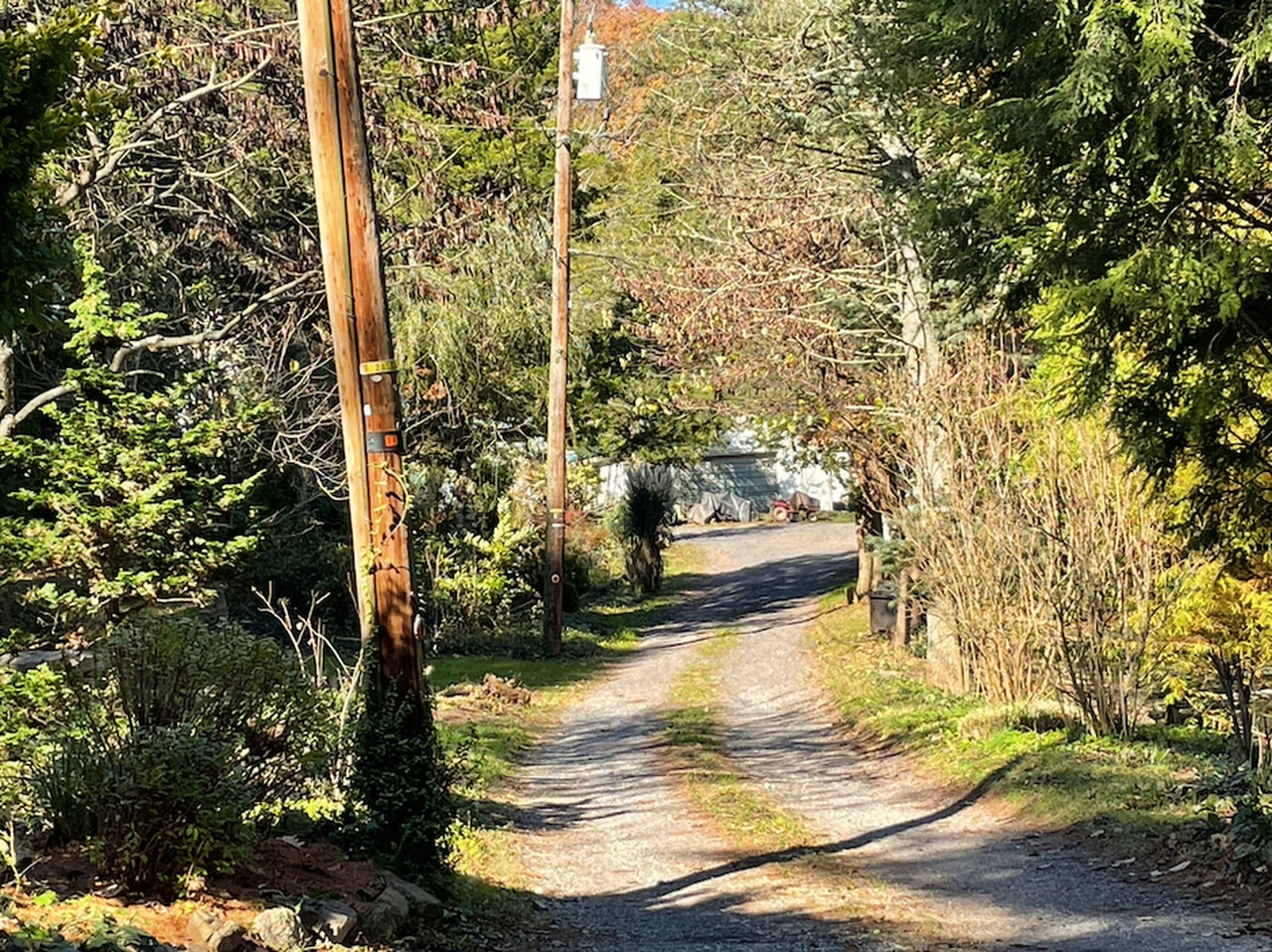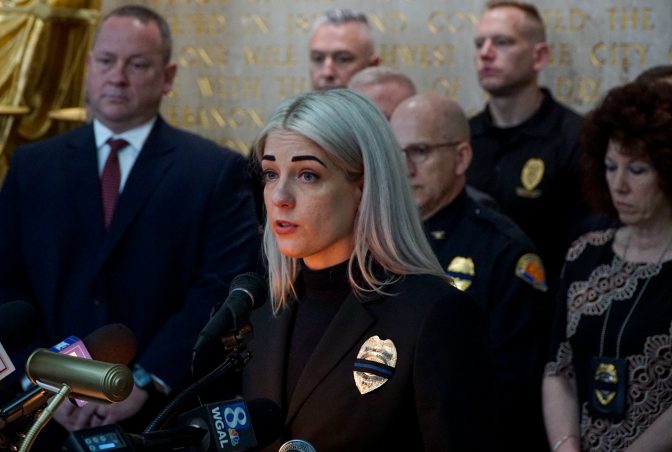
This gravel driveway in rural Union Township, Lebanon County, leads to the home where a trooper shot and killed Andrew Dzwonchyk.
Steve Marroni / PennLive.com

This gravel driveway in rural Union Township, Lebanon County, leads to the home where a trooper shot and killed Andrew Dzwonchyk.
Steve Marroni / PennLive.com

Steve Marroni / PennLive.com
This gravel driveway in rural Union Township, Lebanon County, leads to the home where a trooper shot and killed Andrew Dzwonchyk.
A Pennsylvania state trooper who has killed four people over 15 years was justified in fatally shooting a man last year, according to a ruling by the Lebanon County District Attorney announced Monday.
District Attorney Pier Hess Graf said Trooper Jay Splain reasonably feared for his partner’s safety when he killed Andrew Dzwonchyk, 40, of Jonestown the night of Nov. 7 after Dzwonchyk violated a protection from abuse order at his former girlfriend’s home in Union Township.
Dzwonchyk was trying to avoid arrest when Splain’s partner, Justin Achenbach, leaned into Dzwonchyk’s driver’s side window of his Volkswagen Beetle, according to the report. Achenbach still was partially inside the Beetle when Dzwonchyk started to drive away, then stopped and put it in reverse, the report said.
Splain fired at Dzwonchyk on two separate occasions that night, which was among some of the new details in the report about the incident in the first block of Ridge Road. Splain first shot Dzwonchyk in the arm, then fired a Taser twice, before he fired again, killing him.
Both uses of deadly force were permissible by law, Graf concluded, because he first was trying to stop Dzwonchyk from fleeing an arrest for a forcible felony, which was an “aggravated assault” for driving with the trooper in his window. The second volley of gunfire also was justified, Graf said, because it was the third time Dzwonchyk had “dragged” Achenbach and Splain believed at that moment that he or his partner were going to get seriously injured or killed by the car.
Dzwonchyk had methamphetamine and Amphetamine in his system, Graf said.
As part of her explanation into why no criminal charges were warranted in the killing, Graf addressed news reports that showed Splain has killed four people on duty and said the number of killings wasn’t relevant to this particular investigation. She noted that he had responded to 8,025 known incidents such as traffic stops or crime scenes in his career.
“Thus, in the thousands of instances during which Trooper Splain acted as a state trooper, he fatally utilized a firearm on only four occasions.”
She then did the math and said the percentage of times he used deadly force as a police officer was .00048 percent.
But what she didn’t address was that most police officers go through their entire careers without firing their guns at a call. In fact, during Splain’s time on the force, he has been responsible for four of the nine fatal shootings by troopers in the three counties where they occurred, according to an investigation by the New York Times.
Officers involved in multiple shootings may work in high-risk units like SWAT, where they could face violent, unpredictable situations. But because police shootings overall are so rare, and because Splain works as a trooper in rural areas, questions have been raised about the number of times he has opted for deadly force.
A former longtime police chief who now helps run a policing research institute at Florida State University, told the New York Times that the four shootings represent a “red flag.”
“Four is incredibly unusual,” he told the Times. “That is out there on the edge.” Even if the shootings can be legally justified, he said, the pattern needs to be “examined very closely” to determine why the same officer repeatedly resorted to deadly force. “Because they can, it doesn’t mean they should,” he said.
The last two fatal shootings by Splain, both involving unarmed people behind the wheel of a car, occurred in Lebanon County, and were ruled justified by Graf, who is married to a state trooper who used to supervise Splain.

Jeremy Long / WITF
Lebanon County District Attorney Pier Hess Graf releases more details about the shooting that killed Lt. William Lebo on March 31, 2022. Two other officers were also wounded. The shooter, Travis Shaud, was also killed in the shootout.
The connection has raised questions of a possible conflict of interest for Graf.
But Graf noted in her report that her husband had moved out of Splain’s barracks in the past year, so he didn’t work with Splain during the second fatal shooting in the county. Since her husband, a corporal, was not involved in the fatal shooting, Graf said she did not need to recuse herself from overseeing the investigation.
The “mere allegation of a conflict” is not enough of a reason to give to refer the case to the Attorney General’s office, she said.
Many large police departments ban shooting at moving vehicles because it is often ineffective, unnecessary and can cause more danger.
“If the officer successfully hits the driver, now he has an injured or possibly dead person operating a motor vehicle, that creates its own dangers,” Justin Nix, an associate professor of criminal justice at the University of Nebraska Omaha, previously told PennLive.
One discrepancy in Graf’s report is the speed at which Dzwonchyk was traveling when he drove down the gravel driveway and when he put his car in reverse after he found the driveway blocked by the trooper’s patrol car.
The morning after the shooting, a spokesman said the vehicle, which is a stick shift, was not traveling fast, but Graf’s report said the car was traveling at a “high rate of speed.” Her office did not respond to questions about the discrepancy.
The report did not include details such as the estimated speed of the vehicle, which arm Dzwonchyk was shot in during the first act of deadly force, how Splain could shoot the driver of a moving car with the trooper in the window without hitting his partner, nor any references to time other than the two stun gun blasts were within 10 seconds of each other.
Because Dzwonchyk was wearing a heavy coat, the first stun gun did not deter him and the second Taser attempt hit the vehicle not Dzwonchyk, according to the report.
The report also didn’t say how many bullets Splain shot at Dzwonchyk, other than to state he still had bullets left in his gun after the killing.
The report pointed out two difficulties with the incident, which involved an ongoing dispute between Dzwonchyk and the mother of his two children. She had obtained a protection from abuse order against him weeks prior to the deadly encounter on Nov. 7.
On that day, his ex had called him to ask if he could repair her car. She then dropped it off at his home, but got scared and called police when he wouldn’t return it and instead asked her to come over to pick it up.
While police were at her home, Dzwonchyk repeatedly texted her, violating the PFA order, according to Graf.
Then Dzwonchyk showed up at her home while the troopers were there and started yelling at her. When the troopers told him to get out of his car so they could arrest him, he said no, locked the car door and started to drive away after the trooper leaned into his window and grabbed at the steering wheel.
As it turned out. Dzwonchyk had texted his former girlfriend 325 times that day and called her 13 times. The situation illustrates a problem with PFA orders involving people who share children and don’t have a formal custody plan.
In this case, Dzwonchyk and his ex were allowed to contact each other to make custody arrangements, but it creates a difficult situation and puts police in a bad position trying to determine which contacts are allowed or not. Graf’s report suggested that PFAs should require detailed, formal custody arrangements ahead of time to avoid this kind of problem.
The other issue Graf outlined in her report was the fact that there are penalties for people who violate a PFA order but it doesn’t apply to the person who applied for the order, as was the case when Dzwonchyk’s former girlfriend asked him to repair her car. She could contact him but he could not contact her, leading to confusion and problems, Graf wrote, suggesting a better system would prevent either party from contacting the other.
Splain’s prior fatal shootings include the March 2020 killing of an unarmed woman in Lebanon County after a car chase. Police said Charity Thome, 42, was killed when she tried to use her car as a weapon after Splain forced her car off the road and into a field. But her family has disputed the police account and filed a lawsuit saying she was outside of her car and posed no threat when she was shot.
According to the Times, Splain also killed a disturbed man in Northampton County in 2017 who had threatened to blow his own head off with an explosive. That man, Anthony Ardo, was shot as he sat in his car, apparently lighting a firework he had draped around his neck, police said.
Splain’s first known fatal shooting occurred in Lehigh County in 2007 when he killed a mentally distraught man who allegedly pointed a gun at him.

A collection of interviews, photos, and music videos, featuring local musicians who have stopped by the WITF performance studio to share a little discussion and sound. Produced by WITF’s Joe Ulrich.
The days of journalism’s one-way street of simply producing stories for the public have long been over. Now, it’s time to find better ways to interact with you and ensure we meet your high standards of what a credible media organization should be.